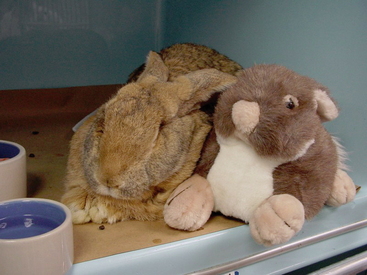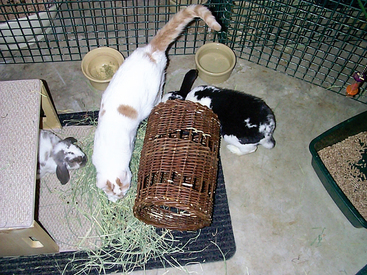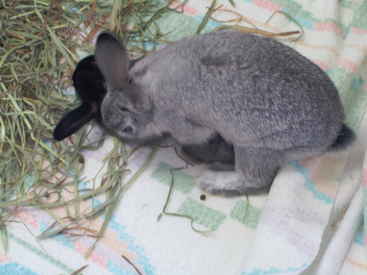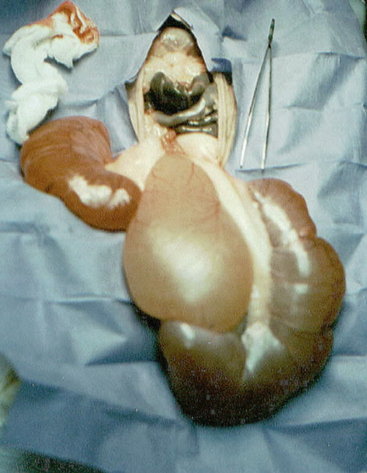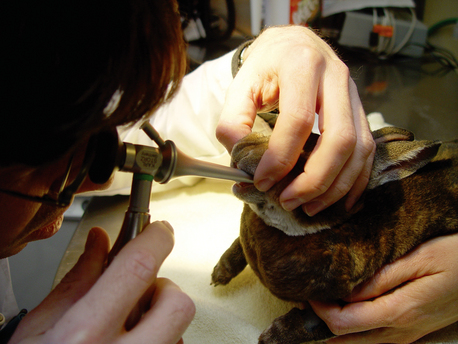CHAPTER 1 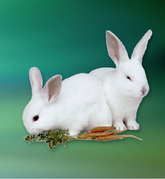 RABBIT BEHAVIOR
RABBIT BEHAVIOR
Introduction
Knowing the specifics of rabbit anatomy and physiology and how these differ from those of other mammals is imperative for veterinarians who treat exotics. Rabbits, like other exotic species, cannot be treated successfully by extrapolating from cat or small dog medical principles. Equally important is the need to become familiar with normal and abnormal behavior in order to provide the best health care possible for rabbit patients.
Natural History, Behavior, and Domestication
Domestic rabbits are the descendants of the European rabbit, Oryctolagus cuniculus, from Western Europe and Northwestern Africa, and have been kept as domesticated pets since the early sixteenth century.12,16 Many of the behaviors that we see in wild rabbits are mimicked in our pet rabbits.
The males are very territorial, and females will aggressively protect their nests. Pregnant females will dig burrows away from the warren, as the males can be aggressive toward and even kill the offspring. When the kits are small, the doe will carefully cover the nest burrow each time she leaves it.
Although rabbits have been domesticated for more than 2000 years,85 the behavior of rabbits was relatively ignored until the pioneer observations of Southern88,89 in the British Isles. Then, in the 1950s, the Australian government initiated an extensive rabbit research program in which the reproductive and general social behavior of the Australian wild rabbit was intensively studied.43,73–76 However, in contrast with the aim of improving the well-being of laboratory rabbits, the goal of the Australian program was to find suitable methods for eliminating the wild rabbit population, which was vastly overabundant and creating an agricultural nuisance.68,70
Until the 1990s, studies of rabbit behavior focused almost exclusively on wild rabbits, in natural colonies,22,59,79,82,89 and in experimental colonies.71,90 There were relatively few investigations conducted on the behavior of single rabbits in cages or small pens.54,55,61,65,90 The studies showed, however, that the behavior of wild and domestic rabbits is very similar.
The major behavioral difference between wild and domestic rabbits is their response to confinement. Wild rabbits do not adapt well to cages, often fail to breed, and exhibit abnormal behavior not seen under natural conditions. Other wild lagomorphs such as hares are resistant to domestication and cannot be successfully raised in cages. Taming of wild rabbits should therefore not be attempted, as it is very stressful to them and seldom successful. In contrast, domestication of rabbits has resulted in an animal with a more placid disposition with humans and that is not stressed by confinement, retaining most of the other behavioral repertoires of its wild ancestors.6 Selective breeding has created over 100 recognized breeds, although many domestic rabbits are the result of hybrid breeding.
Sensory Behaviors
Vision and Behavior
A rabbit’s eyes are placed laterally, and the cornea is very large, allowing for an extensive circular field of vision16 like that possessed by most grazing herbivores. This positioning of the eyes, however, does not provide visualization of the area beneath the mouth. Rabbits that have vision problems may move their heads from side to side or up and down as if to focus in order to scan the area around them.9 This scanning behavior is most evident as a visually impaired rabbit is carried around in a room.
Touch and Behavior
The lips and the vibrissae in the area beneath the mouth are sensitive enough to distinguish various food items as the rabbit grazes. Because of this sensitivity and because rabbits are obligate nasal breathers, rabbits do not like to have their noses touched. This should be taken into consideration during examinations and when medicating or teaching clients to medicate their rabbits. Rabbits generally do not like to have hands placed beneath their noses (as one might do when greeting a strange dog). Doing so may cause the rabbit to startle. Rabbits also have long sensory hairs above their eyes and around their noses.36
Hearing and Behavior
The ears of rabbits are very large and highly vascular, allowing for amplification and location of sound, providing an acute sense of hearing,48 and thermoregulation. The ears constitute approximately 12% of the body surface area.23 The ears are often held at odd angles, and the rabbit may shake its head and scratch at its ears with the rear feet if infection or mite infestation is present.
Olfactory Behaviors
Chin glands, which are specialized submandibular glands opening onto the underside of the chin, are used by rabbits to mark almost any physical feature in their environment (see additional information on chinning in Communicative Behaviors). The pair of pocketlike perineal glands known as the inguinal glands and the harderian glands, located around the eye, are both believed to release pheromones that may serve as sexual attractants in both sexes.5 The size of the glands and degree of marking are androgen dependent and related to the level of sexual activity. Males mark more frequently than do females, dominants of both sexes mark more frequently than do subordinates, and dominants mark most in the presence of subordinate rivals. Under natural conditions, both bucks and does in their own territory, surrounded by their own odor and that of their clan, win two thirds of all aggressive encounters.74 Lehmann has suggested that scent-marking of individual animals in a group may represent a form of group identification.55
Large, fibrous fecal pellets can act as a vehicle for these anal gland secretions. Besides the apparently random distribution of pellets throughout their home range, rabbits also deposit pellets at special “dung-heap” or “latrine” sites.5 Bell believes that latrine maintenance may serve several functions: the recognition of own or familiar odors at these sites may have a “confidence-enhancing” effect; the “strangeness” of any odors may inform an intruder that the area is occupied; latrines serve as loci for the indirect exchange of olfactory information among members of the same social grouping and contribute to the regulation of population density by inhibiting reproduction in socially subordinate animals.
Female rabbits will mark their kits with chin and inguinal gland secretions and are openly hostile to young that are not their own.27 They will normally harass young from their own colony, but will actually pursue and kill young from other colonies. Even kits of a doe, smeared with the odor from other rabbits, are attacked and killed.69 Minimally, does will reject strange kits that do not smell the same as the rest of the litter. Successful cross-fostering therefore not only requires having healthy kits with the energy to suckle but also camouflaging their scent by rubbing in the nest bedding and placing them at the bottom of the litter pile.26,48
Enhancement of olfactory cues during mating and nursing has been successfully exploited by rabbit breeders to increase reproductive performance and yields. However, the reproductive component of social olfaction is only one part of a rabbit’s scent-marking repertoire, and a significant part of normal behavior involves maintaining what Bell6 has described as an “optimum odor field.”
Communicative Behaviors
A highly intelligent species, the rabbit is very aware of its surroundings and will initiate play and chase games with other rabbits as well as with people. It has been shown that rabbits can recognize other rabbits as well as individual people.24 Deaf rabbits have been known to respond to hand signals from their owners.57 A list of common behaviors that rabbits use to communicate can be found in Box 1-1.
BOX 1-1 Common Rabbit Postures, Behaviors, and Vocalizations
Adapted from Bradley TA: Rabbits: understanding normal behavior, Exotic DVM Magazine, 2(1):19-24, 2000, and Bradley TA: Rabbits: medical implications of selected abnormal behaviors, Exotic DVM Magazine 2(4):27-31, 2000.
Rabbits are in general very quiet pets, but they do on occasion vocalize. A high-pitched, repetitive scream denotes severe terror or pain. This sound is very much like a human baby crying. Fear may also be denoted without vocalization, by a motionless, crouched position with feet beneath the body, the head extended, ears flattened against the head, and eyes bulging.10 Grunts, growls, and snorts are sometimes used to express anger or annoyance, especially in those guarding their territory or those influenced by hormones. Occasionally a honking or oinking sound will be made to gain food or attention or during courtship. A loud squealing sound may be made when rabbits are picked up and begin to fret.
An alert rabbit will have its ears forward, or the ears may be positioned laterally. A menacing expression is denoted by the ears being pulled back. An erect tail can indicate excitement or anticipation or may occur if a rabbit is threatened. Tail twitching may be noted during courting and often is accompanied by urine spraying (see Male Reproductive Behaviors). When presenting itself to be petted, a rabbit will assume a subordinate position with the feet tucked under the body, the head extended forward, and the chin on the floor.10
Rabbits may lick their human companions as a form of grooming them and as a sign of affection. Nipping is not always done in anger and may be done to indicate the need for attention or a desire for the handler to put the rabbit down or for another rabbit or human companion to move over. If a rabbit nips too hard, the handler should respond immediately with a high-pitched yelp (as a littermate might do during too-rough play fighting) to deter the behavior.81
Rabbits will “thump” by stomping their rear feet when angry and as an alarm to other rabbits; the thumping can be accompanied by dilated pupils, and the rabbit will often also seek refuge. When other rabbits hear the sound, they become quite still. Rabbits may also assume a strained upright stance with the tail stretched out and ears pulled back that indicates readiness to attack. Such rabbits may kick high and backward if a fight occurs. A short barking growl, hissing, or snorting sound may be made to denote aggression and is often noted in the grunt-lunge-bite sequence. Staff members should handle these agitated rabbits carefully, as an angry rabbit can be quite contentious and can inflict injury on the handler (by lunging, kicking, biting, and scratching) or on itself when resisting.
To communicate their presence, intact male rabbits will mark their territory by depositing strong-smelling feces at the periphery of their space. Rabbits may also mark with urine and by “chinning” their environment. They rub the scent gland located beneath the chin to deposit a strong-smelling secretion on inanimate objects including furniture, carpets, and household items (see chinning under Olfactory Behaviors). The chemical composition of chin gland secretions includes 34 volatile components, primarily aromatic and aliphatic hydrocarbons, and differs in animals from different geographic locations.40
The chinning behavior occurs earlier in females than in males, and the frequency increases throughout development because of an increase in sex steroid secretions.35 Does that are pregnant or pseudopregnant exhibit lower rates of chinning than females in any other part of the reproductive cycle.34 The chin gland secretions help to maintain dominance hierarchies in the wild, and dominant rabbits have the additional compound 2-phenoxyethanol, which is a fixative that allows the scent to persist longer in the environment.41
Social and Antisocial Behaviors
Rabbits are the only leporids that live in large stable groups or warrens, sometimes numbering several hundred animals.79 This social nature was not lost during domestication, and rabbits tend to fare better in groups of two or three rather than as solitary pets (Figure 1-1). Unfortunately, until the 1990s this aspect of their sociobiology was neglected by researchers and lay owners alike. Part of the reason was the development of intensive husbandry techniques for breeding domesticated rabbits. This required good infectious disease control, and because these diseases are spread by contact, rabbits were kept isolated from one another in singly housed cages. With the development of specific-pathogen–free rabbits for laboratory research and the virtual absence of infectious rabbit diseases in most animal facilities, isolation of rabbits from one another is no longer the critical practice it once was.
Another reason for housing rabbits singly involved the false belief among rabbit producers that the euphemistically “conventionally housed” rabbit had the greatest growth performance.17 Critical analysis of the growth performance for singly housed rabbits has shown that these animals have a higher amount of intraabdominal fat, abnormal musculoskeletal development associated with their restricted locomotion, and increased carcass damage because of “nervous” confinement-associated behaviors.28
Abnormal repetitive behavior is commonly seen in caged rabbits and includes pawing at the corners of cages, wire-biting, overgrooming, overeating, and playing with the water supply. Studies showed that rabbits group-housed in small social groups exhibited behaviors that included increased exercise and social contact and that individuals exhibited preferences for microenvironments within the enclosures (Figure 1-2).94 Rabbits also engage in “amicable” activities such as lying together, grooming, and nuzzling. Rabbits that isolate themselves from the group should be checked for medical problems. It has been shown that subordinate rabbits exhibit elevated heart rates that adjust to a lower level if the same rabbit achieves a more dominant position.30 Rabbits often mount one another as a show of dominance, often facing the head of the subordinate.10 This can happen regardless of the gender of the dominant or subordinate rabbit and in both intact and altered rabbits.
It has been found that rabbits that are handled in the first week postpartum are less apt to show signs of fear of humans than ones that are not handled.8,80
Introducing a new rabbit should always be done slowly and carefully and with direct adult supervision. The supervisors should be prepared to separate the rabbits if they begin to fight. Many owners wear heavy gloves or put tennis shoes on their hands so they are better protected from being bitten if they have to separate two fighting rabbits.
As with other species, introductions are best performed in neutral territory where neither of the rabbits feel at home (Box 1-2). A dry, clean bathtub may be used, as it is unfamiliar and a little slick and therefore somewhat challenging to the rabbits. Greens and hay can be offered to distract them as well. Placing them in a box or clothes basket and taking them for a long car ride (or circling in an empty parking lot) may also help with bonding, as they tend to comfort each other in the strange surroundings rather than to fight. The bonding process takes time and patience; however, these efforts can be well rewarded, because rabbits are naturally a highly social species. Bonding will be evidenced by mutual grooming and nose-to-nose, nose-to-body, and full-body contact.7
BOX 1-2 Suggestions for Bonding Rabbits
It should be remembered that not all personalities get along well, just as with people. If rabbits are not able to be bonded, it is important to make sure that their enclosures are not kept too close to each other, as severe injuries can be inflicted on rabbits through cage wires. Clients should be counseled that multiple enclosures or separate rooms or areas might be needed if bonding is not successful.
Young rabbits that do well in a home may become aggressive and destructive as they reach sexual maturity. At as early as 3 to 4 months of age, does often become more aggressive to people and to other rabbits and pets, they can have intense mood swings, they mount companions, they spray urine, and they may begin digging and nesting. Bucks also become more aggressive at about 4 to 5 months of age and spray urine and may also mount objects, people, and other pets. Both males and females that were previously litter-box trained begin to urinate and defecate randomly to mark their territory. Clients should be counseled to have their rabbits altered, preferably before the onset of sexual maturity, in order to decrease these behaviors (see Male Reproductive Behaviors and Female Reproductive and Maternal Behaviors).
With time and patience rabbits may also get along with other pets including cats, birds, guinea pigs, and dogs. For example, rabbits were found to show no fear of cats if they were exposed to them before being weaned.80 Their interactions should never be unsupervised, however, as instinct is a prominent driving force in all species. Any signs of aggression should indicate that predator (cats and dogs) and prey (rabbits and guinea pigs) species may not get along, and close interaction should be prevented. Although they can often cohabitate well with guinea pigs, rabbits can harbor Bordetella bronchiseptica subclinically, and this organism is pathogenic in cavies. Alternatively, guinea pigs may harbor Pasteurella and represent a source of infection to rabbits.
Reproductive Behaviors
Male Reproductive Behaviors
Sexual behaviors of male rabbits include urine spraying and “chinning” objects to mark them with the scent glands that are located under the chin. The buck will sniff at, lick, nuzzle, groom and follow the doe and exhibit tail flagging. Enurination, or spraying of a jet of urine on the female, is another courtship behavior. Bucks will also mount and hump inanimate objects, other pets, and humans and will circle the doe or other “object of affection,” often while making a soft honking sound (Figure 1-3).
Males in the presence of unfamiliar females exhibit sexual behaviors regardless of whether or not the females are receptive.92 If the female is receptive, mating occurs quickly. The male grasps the female by biting the nape of her neck, and ejaculation occurs shortly after intromission. When mating is complete, the buck falls over on his back or on his side after mounting the doe, and he may emit a sharp cry. Males may take part in the caring of the young.
Neutered male rabbits tend to make better pets, as they are less territorial and they will mark less with both urine and feces. Neutered rabbits also tend to fight less with other rabbits. Behavioral changes stemming from decreased hormonal influence often are not apparent for 30 days or more after neutering. It has been found that some bucks with prior breeding experience, however, continue to exhibit sexual behaviors, including mounting, for up to 10 weeks postcastration.1 Larger breeds may take up to 6 months for these negative sexual behaviors to decrease.81 Males may also have viable sperm for a short time after neutering; therefore they should be kept separate from intact females for at least 4 to 6 weeks.
Female Reproductive and Maternal Behaviors
In the wild, matings are generally polygynandrous,* although males will attempt to monopolize particular females.93 The estrous cycle of rabbits varies from 4 to 17 days in the absence of mating, and mating induces ovulation. Gestation lasts from 29 to 35 days, and litter sizes range from 4 to 10. Females have 3 to 5 pairs of mammary glands, which increase in size several days before kindling.
Sexual behaviors may be noted when a female is introduced into the cage of a male. Receptive females will either flatten to the floor or circle. Other behaviors that indicate sexual receptivity in the doe include lordosis and hyperactivity (except when mounted by the male). Lordosis occurs when pressure is placed over the back (such as when mounted) and the pelvis is raised in an effort to present the perineum to the male. The restless doe shows increased interest in other rabbits and rubs her chin on enclosures and objects. The vulva also becomes congested, moist, and a deeper purplish-tinged color.
Does tend to be more receptive when progesterone levels are lower.92 A doe that is not receptive will react to the male by running away, cornering the male, biting, and vocalizing.27 Rabbits are induced ovulators, and ovulation occurs approximately 10 to 13 hours after copulation. If the doe is stressed by overcrowding, predators, or disease, she may resorb the embryos at midterm. In this case, lactation will still occur, and she will come into estrus just as she would have if parturition had occurred normally.66
The female’s body temperature decreases during the last two thirds of pregnancy.52 Nesting occurs from a few days to a few hours before parturition, and does will pull fur from their dewlap, abdomen, and sides to line the nest. Food intake decreases in the 48 hours prepartum.33
Regulation of nest building is dependent on hormones, but maintenance of maternal behavior is stimulated by the presence of the litter.32 Kindling usually occurs in the morning hours, and uncomplicated parturition normally is accomplished within 30 minutes. It is not unusual for kits to present in anterior or breech positions. Any evidence of straining without production of kits beyond 30 minutes indicates the need for immediate veterinary intervention.
Primiparous does and those of smaller breeds usually produce smaller litters of four to five kits, whereas larger breeds may produce litters of 8 to 12 kits.27 Rabbits are placentophagic.63 Does usually nurse for a very short period of time (usually less than 4 minutes), in the morning or evening,15,51,86 spending the rest of the time out of the nest. This limited nursing behavior leads many clients to think that wild rabbit does have abandoned their litters. Clients should be instructed to leave a wild rabbit nest alone, as the doe is probably nearby.
The presence of young kits stimulates milk production in the female, whereas older kits inhibit production.64 Females are able to recognize their kits by their odors. A specific compound, dodecyl propionate, which is released by the kit’s preputial glands, will stimulate the maternal anogenital licking behavior.56 As stated previously, females are unlikely to foster kits from other litters unless they have been rubbed with the scent of the litter and the bedding26,48(see Sensory Behaviors). A gland in the region of the nipple produces a pheromone that attracts kits.
Intact female rabbits over the age of 2 years have an extremely high rate of neoplasia in the reproductive tract, especially uterine adenocarcinoma (Figure 1-4).84 Clinical signs can include hematuria or serosanguineous vaginal discharge, cystic mastitis, and increased aggressiveness. Often, frank blood is most evident at the end of urination.78 Mammary tumors are also common.
Rabbits should be spayed when they are approximately 4 to 6 months of age. A rabbit is a better surgical candidate if these surgeries are done prophylactically rather than when the rabbit is older and possibly more compromised from preexisting disease. Older intact female rabbits in good health, however, should also be considered candidates for ovariohysterectomy, because early reproductive disease may not be evident. Uterine adenocarcinoma is a relatively slow-growing neoplasm,16 so uterine tumors may be removed through ovariohysterectomy potentially before metastasis occurs.
Neonatal and Juvenile Behaviors
Newborn kits are altricial and they are born without hair, their eyes are closed, and they require anogenital stimulation for elimination. Newborn rabbits compete vigorously for the doe’s milk, so they may actually benefit from the death of littermates. They are, however, very prone to hypothermia, and because the doe spends the majority of the day away from the nest, those raised alone have lower body temperatures and are less likely to survive.4 The kits huddle together in the nest to keep warm for the first 10 days of life, until their fur grows in.46 In the wild, mortality rates in the first year of life have been reported to be as high as 90%.93
Kits have been shown to be equally attracted to the odors of placentae and colostrum, and it is believed that the fetoneonatal transitional environment affects the ability of the kits to obtain colostrum and milk readily.20 They are able to respond to pheromonal cues for nipple-search behavior and are able to recognize them even when they have been delivered by cesarean section.44 Once nursing is established, however, it appears as though the intraoral stimulation associated with sucking is an important reinforcer to nursing even when a novel odor is applied.45
Experimentally, kits have been found to show a preference during the nipple-search behavior for females in early lactation.21 They ingest more than 30% of their body weight during the daily feeding by the seventh postpartum day,15 although milk yield decreases after lactation day 19.33 Kits begin to leave the nest and eat solid food at approximately 3 weeks of age. They are usually weaned at approximately 42 days of age. It is less stressful on the weanlings at this time to be left in the familiar cage and to remove the doe.13
Eating Behaviors
In the wild, rabbits are herbivorous, selective feeders that prefer the more tender portion of plants and also consume small amounts of coarse roughage to aid in gastrointestinal motility. The dentition of rabbits allows for cutting the vegetation with the incisors and grinding it with the premolars and molars. Food is chewed thoroughly with a lateral motion of the jaws, highly organized tongue movements, and up to 120 jaw movements per minute.19
High-fiber diets stimulate cecocolic motility because of the “scratch factor” and the distending effect of the bulk.49 Fiber also creates a latticelike food ball in the stomach that allows for penetration of gastric acids.16 Rabbits kept on low-fiber diets, on the other hand, are predisposed to hypomotility and reduced feed intake. Often a hard mass of food is created in the stomach that cannot be as easily penetrated by stomach acids and, especially in light of decreased water intake, can create obstruction. As herbivores, rabbits should be fed mostly green leafy vegetables, free-choice grass hay, and only a small amount of pellets daily.
A variety of fresh green, leafy vegetables should be offered twice daily, in the morning and in the early evening, the two times of the day when rabbits are most likely to be active. Recommended greens include the following: collard greens, endive, dandelion greens and flowers (no pesticides), carrots and carrot tops, mustard greens, parsley, cilantro, snow peas, romaine lettuce (not iceberg or head lettuce), red and green leaf lettuce, watercress, bok choy, clover, celery, and broccoli (mostly leaves and stems). Spinach and kale may also be offered in small amounts occasionally. Small amounts of fruit may be offered occasionally, as long as loose stools do not result, including apple, strawberries, melon, peach, and pear.
Rabbits will drink 50 to 150 mL (1.6 to 5 oz) of water per kilogram per day,16 which is more than most other mammals. This is important to realize when calculating fluid therapy for rabbits. Common dosages (mL/kg/day) used in cats and dogs are not enough to adequately hydrate a rabbit. Polydipsia will occur if food is withheld or if renal pathology is present. Anorexia will occur with water deprivation. Water consumption may be decreased if consumption of fresh green vegetables increases. It is therefore important to question clients about water intake and how water is provided when assessing clinical signs and symptoms in rabbits.
Limited oral examination in an unanesthetized rabbit may be accomplished using an otoscope with a large aural cone and should be part of every routine rabbit physical examination (Figure 1-5). These so-called “chew” cones are kept separately from the aural cones. Obvious dental spurs and oral lesions may be readily seen; however, resistance to examination with an otoscope cone and increased amounts of saliva noted in the mouth (especially if both are noted unilaterally) may indicate less obvious problems that warrant further investigation with the rabbit under anesthesia.
Stay updated, free articles. Join our Telegram channel

Full access? Get Clinical Tree


